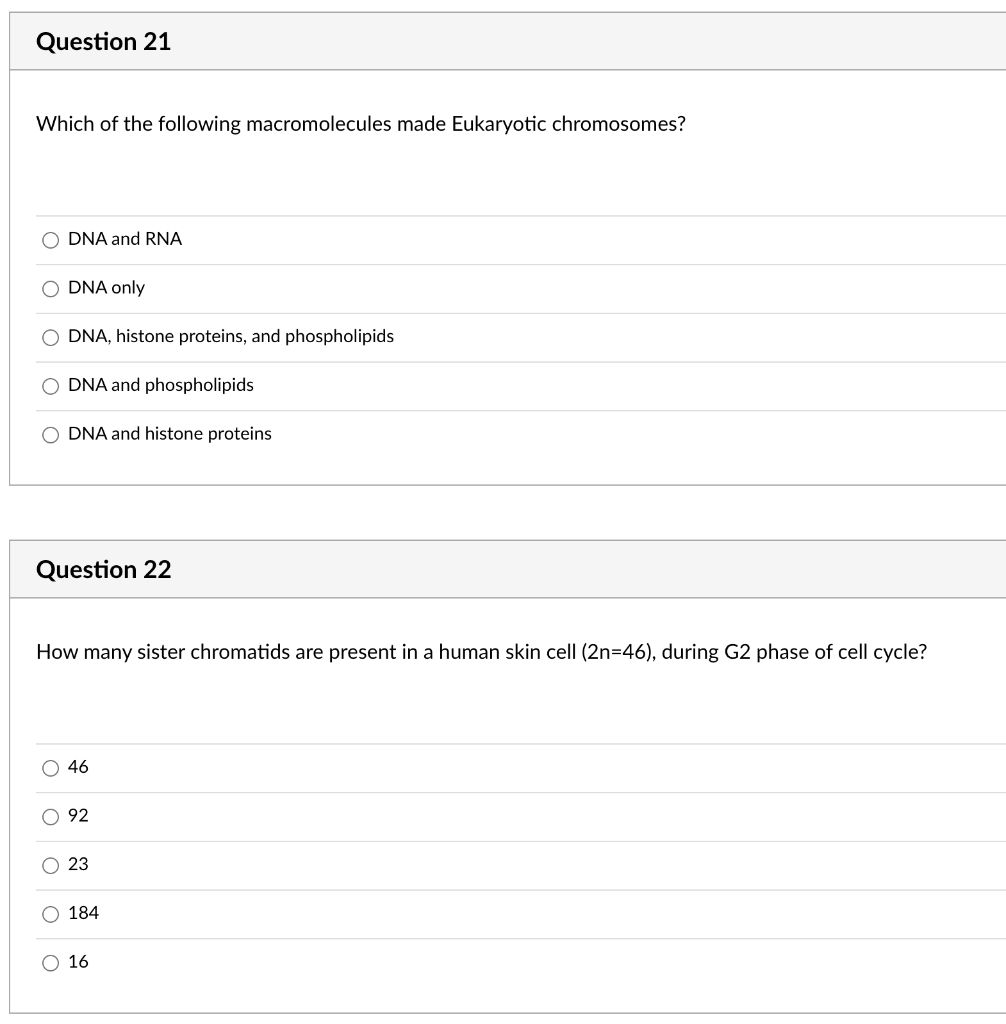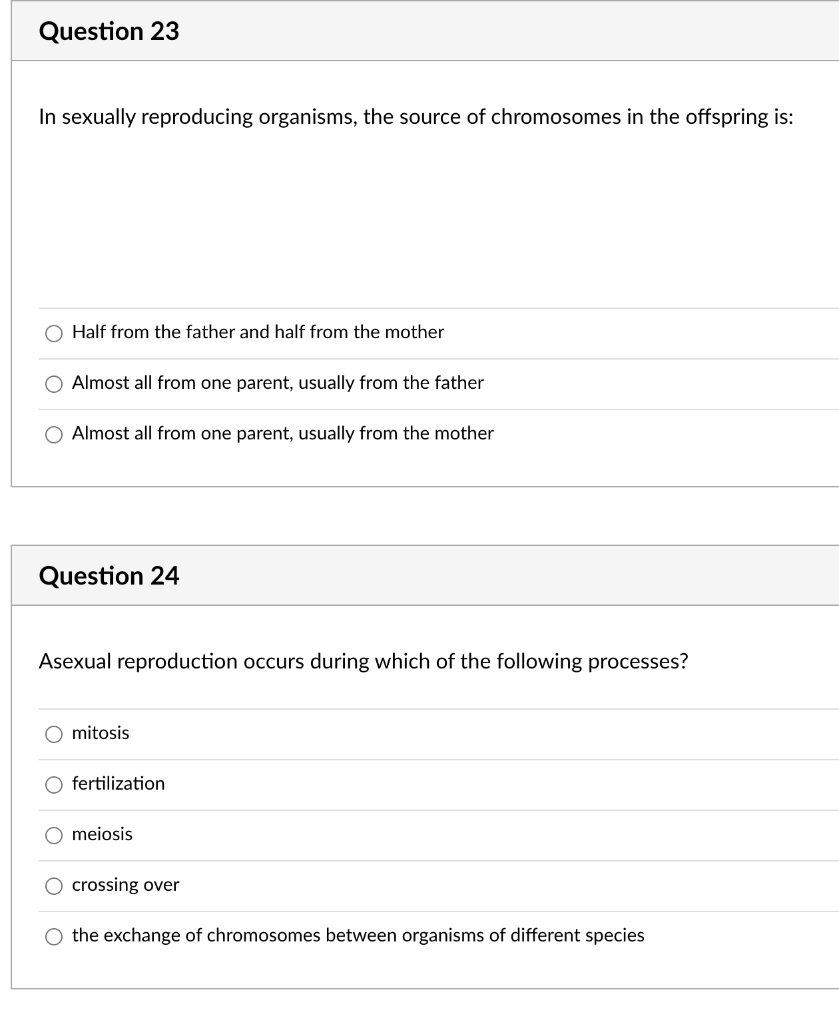Eukaryotic Chromosomes Are Composed of Which of the Following Macromolecules
A DNA molecule is composed of a continuous string of deoxyribonucleotides. Eukaryotic chromosomes are very long molecules of double helix DNA The DNA of each chromosome is a long chain of double-stranded DNA in interaction with proteins histones and non-histones that can be.

Solved Question 21 Which Of The Following Macromolecules Chegg Com
A single bare molecule of RNA.
. Nucleic acid and protein. Nitrogen bases on the outside with sugar-phosphate in the middle of a double helix. Chromosomes are made up of a DNA-protein complex called chromatin that is organized into subunits called nucleosomes.
Eukaryotic chromosomes correspond to the linear structure that is comprised of two macromolecules namely DNA deoxyribonucleic acid and proteins histones. The way in which eukaryotes. D a single linear molecule of double-stranded DNA plus proteins.
Sugar-nitrogen base backbone with phosphates in the middle forming a double helix. The DNA is wrapped around an protein complex composed of 8 subunits called a histone. The former macromolecule DNA is negatively charged that wraps around the latter macromolecule that is proteins which include histones that possess positive charges on them.
The DNA is wrapped around the protein complex known as the histone protein which is composed of 8 subunits known as histone. Each chromosome is made of protein and a single molecule of deoxyribonucleic acid DNA. Passed from parents to offspring DNA contains the specific instructions that make each type of living creature unique.
A DNA and RNA b DNA only c DNA and proteins d DNA and phospholipids. The eukaryotic chromosomes consists of the DNA -protein complex which is organized in a complex manner. They isolate a group of cells that have 1 12 times more DNA than G1 phase cells.
Each eukaryotic chromosome is composed of DNA coiled and condensed around nuclear proteins called histones. The nucleosome is its most basic functional subunit The number of genes on each chromosome is different in. A chromosome is composed of DNA and proteins.
Question 21 Which of the following macromolecules made Eukaryotic chromosomes. Chromosomes in the nucleus. Question 1 A What is the term for a section of a DNA molecule that codes for proteins.
The histone proteins in these cells are H1 H2A H2B H3 H4 which are important for the formation of chromosome structure or condensation of DNA. Eukaryotic chromosomes are composed of chromatin and each consists of two complementary strands of DNA coiled tightly around histones. Scientists isolate cells in various phases of the cell cycle.
B a series of nucleosomes wrapped around two DNA molecules. What is the most likely part of the cell cycle. Chromosomes are the nuclear components of the special organization individuality and function that are capable of self-reproduction and play a vital role in heredity mutation variation and evolutionary development of the species.
A It is composed of DNA alone. It consists of a single linear molecule of double-stranded DNA plus proteins. Nucleic acid and polysaccharides.
DNA and RNA o DNA only DNA histone proteins and phospholipids o DNA and phospholipids ODNA and histone proteins Question 22 How many sister chromatids are present in a human skin cell 2n46 during G2 phase of cell. The structure of chromatin is scaffolded with three distinct levels. 1 point chromosome cytosine gene deoxyribose Question 2 A Eukaryotic chromosomes tend to be much larger than prokaryotic chromosomes.
Humans inherit one set of chromosomes from their mother and a second set from their father. Which of the following statements describes the eukaryotic chromosome. In the case of eukaryotic organisms the chromosome is born primarily from the interaction between DNA histones proteins and non-histonic proteins.
Genes Chromosomes and DNA Quick Check. A single bare molecule of DNA. Answer 1 of 2.
Right before cell division starts the master control of mitosismeiosis called MPF will phosphorylate these. Bio Quiz 6docx - 1. These nucleotides are composed of.
We refer to this complex as chromatin. Each chromosome in a eukaryotic cell is made up of DNA which is coiled and condensed around an octamer of basic proteins called histones. 5-Carbon sugar deoxyribose Nitrogenous base Adenine Thymine Guanine Cytosine Phosphate group Watson and Crick Model of DNA Structure.
Protein molecules of the chromosomes. In eukaryotic cells chromatin consists of all the DNA within the nucleus and its associated proteins called histones. Thus each sister chromatid is composed of one of the two progeny DNA molecules produced by the replication of the parent DNA molecule and each progeny DNA molecules has one old and one new strand.
A a single strand of DNA. Eukaryotic chromosomes are composed of which of the following macromolecules. Biology questions and answers.
Active transcription occurs on heterochromatin but not euchromatin. This is done in order to compact more amount of DNA in the nucleus of the cell. Chromosomes are composed of.
Each chromosome is made up of DNA tightly coiled many times around proteins that support its structure. The correct answer is A. Sugar-phosphate backbone with nitrogen bases coming off a single helix.
He showed that the chromosomes replicated in a semiconservative manner and proposed that each chromatid was made up of a single DNA molecule. DNA and proteins 2. C a chromosome with different numbers of genes in different cell types of an organism.
A Chromosomes in eukaryotes are made of DNA wrapped around proteins. Chromosomes in nucleus and cytoplasm. Eukaryotic chromosomes are composed of which of the following macromolecules.
The following are the Watson and Crick conclusions regarding the structure of the DNA model. Starting with a fertilized egg.

Solved Question 21 Which Of The Following Macromolecules Chegg Com
What Are Chromosomes Made Of And What Macromolecules Does This Belong To Quora
What Are Chromosomes Made Of And What Macromolecules Does This Belong To Quora
No comments for "Eukaryotic Chromosomes Are Composed of Which of the Following Macromolecules"
Post a Comment